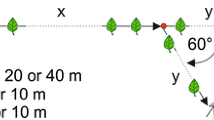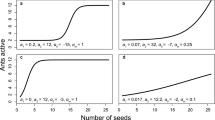Summary
Individual scouts ofFormica oreas are capable of communicating resource availability, location and quality to nest mates. Recruited foragers can perceive and respond to differences in recruitment stimuli of individual scouts. Significantly more workers followed the path of an individual scout from a more rewarding food source than from a less rewarding food source. These findings suggest recruitment in ant colonies is regulated by recruited workers “weighing” recruitment stimuli of scouts returning from numerous areas about the nest.
Resume
Chaque fourmi éclaireuse est capable de communiquer la disponibilité, le lieu et la qualité des ressources trouvées. Les fourmis ouvrières recrutées peuvent, pour récolter ces ressources, reconnaître les différences des stimuli de recrutement de chaque éclaireuse et y répondre. D'une manière significative, davantage d'ouvrières suivent le chemin de l'éclaireuse qui a trouvé la source de nourriture la plus riche. Ces résultats suggèrent que le recrutement dans les colonies de fourmis est déterminé par les ouvrières recrutées qui «savent analyser» les stimuli de recrutement des fourmis éclaireuses revenant à la fourmilière.
Similar content being viewed by others
References
Cammaerts M., 1977. — Recrutement d'ouvrières vers une source d'eau pure ou sucrée chez la fourmiMyrmica rubra L. (Formicidæ).Biol. Behav., 2, 287–308.
Chadab R., Retienmeyer C.W., 1975. — Mass recruitment by army ants.Science, 188, 1124–1125.
Hangartner W., 1969. — Structure and variability of the individual odor trail inSolenopsis geminata Fabr. (Hymenoptera, Formicidæ).Z. Vergl Physiol., 62, 111–120.
Hartwick E.B., Friend W.G., Atwood C.E., 1977. — Trail-laying behaviour of the carpenter antCamponotus pennsylvanicus (Hymenoptera: Formicidæ).Can. Entomol., 109, 129–136.
Hollander M., Wolfe D.A., 1973. —Nonparametric statistical methods. John Wiley & Sons publ., New York.
Hölldobler B., 1971. — Recruitment behavior inCamponotus socius (Hym. Formicidæ).Z. Vergl. Physiol., 75, 123–142.
Hölldobler B., 1976. — Recruitment behavior, home range orientation and territoriality in harvester antsPogonomyrmex.Behav. Ecol. Sociobiol., 1, 3–44.
Hölldobler B., 1977. — Communication in social hymenoptera. In:How animals communicate (T. Sebeok, ed.). Indiana Univ. Press, Bloomington, Indiana.
Hölldobler B., Stanton R.C., Markl H., 1978. — Recruitment and food-retrieving behavior inNovomessor (Formicidæ, Hymenoptera). I: Chemical signals.Behav. Ecol. Sociobiol., 4, 163–181.
Hölldobler B., Wilson E.O., 1970. — Recruitment trails in the harvester andPogonomyrmex badius.Psyche, 77, 385–399.
Möglich M., Hölldobler B., 1975. — Communication and orientation during foraging and emigration in the antFormica fusca.J. Comp. Physiol., 101, 275–288.
Parry K., Morgan E.D., 1979. — Pheromones of ants: a review.Physiol. Entomol., 4, 161–189.
Rosengren R., 1971. — Route fidelity, visual memory and recruitment behavior in foraging wood ants of the genusFormica (Hymenoptera: Formicidæ).Acta Zool. Fenn., 133, 3–106.
Sather D.A., 1972. — Nest morphogenesis and population ecology of two species ofFormica. Ph.D. Thesis, University of North Dakota.
Siegel S., 1956. —Non-parametric statistics. McGraw Hill, New York, N.Y.
Szelp-Fessel R., 1970. — The regulator mechanism in mass foraging and the recruitment of soldiers inPheidole.Ins. Soc., 17, 233–244.
Szelp R., Jacobi T., 1967. — The mechanism of recruitment to mass foraging in colonies ofMonomoium venustum Smith,M. subopacum ssp.phœnicium EM.,Tapinoma israelis For. andT. simothi v.phœnicium Em.Ins. Soc., 14, 25–40.
Taylor F., 1977. — Foraging behavior of ants: experiments with two species of Myrecine ants.Behav. Ecol. Sociobiol., 2, 147–167.
Taylor F., 1978. — Foraging behavior of ants: theoritical considerations.J. Theor. Biol., 71, 541–565.
Traniello J.F.A., 1977. — Recruitment behavior, orientation and the organization of foraging in the carpenter antCamponotus pennsylvanicus De Gree (Hymenoptera: Formicidæ).Behav. Ecol. Sociobiol., 2, 61–79.
Wallis D., 1964. — Foraging behavior ofFormica fusca.Behaviour, 23, 149–175.
Weber N.A., 1935 — The biology of the thatching antFormica rufa obscuripes Forel. in North Dakota.Ecol. Monog., 5, 165–206.
Wilson E.O., 1962. — Chemical communication among workers of the fire antSolenopsis sœvissima (Fr. Smith). I: Organization of mass foraging.Anim. Behav., 10, 134–164.
Wilson E.O., 1971. —The insect societies. Belknap Press publ., Cambridge, Mass.
Author information
Authors and Affiliations
Rights and permissions
About this article
Cite this article
Crawford, D.L., Rissing, S.W. Regulation of recruitment by individual scouts inFormica oreas Wheeler (Hymenoptera, Formicidae). Ins. Soc 30, 177–183 (1983). https://doi.org/10.1007/BF02223867
Received:
Accepted:
Issue Date:
DOI: https://doi.org/10.1007/BF02223867




